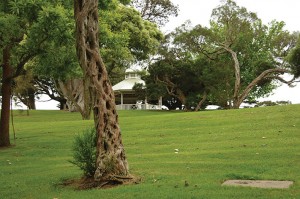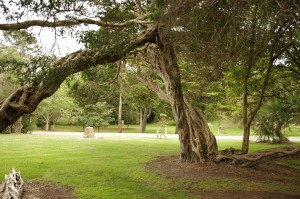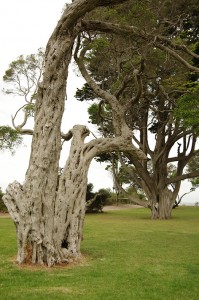Words and pictures by Keith Platt

 If left to their own devices, moonah trees generally grow in a woodland, part of a community that will include other coastal species such as tea tree, wirilda, and beard-heath.
If left to their own devices, moonah trees generally grow in a woodland, part of a community that will include other coastal species such as tea tree, wirilda, and beard-heath.
At Sorrento Park the moonahs are remnant examples of what once was.
As survivors they are a reminder of the past. The largest ones would have been growing soon after Europeans began regularly sailing through The Heads into Port Phillip.
If these trees could talk, their tales would be fascinating, encompassing the arrival of the Europeans and the lives of Aborigines who roamed what was later to be named the Morn ington Peninsula.
ington Peninsula.
Today, Sorrento Park is a manicured garden, with expansive lawns, garden beds, bitumen paths, barbecues, a children’s adventure playground and a rotunda.
One of the paths follows the clifftop, overlooking Sorrento pier in one direction and a succession of privately owned jetties stretching back toward Point King in the other. The beaches near the jetties are open to the public but are relatively exclusive because access is limited.
The park has been a drawcard and a haven for families since the 1870s. An 1876 brochure described it as “A government reserve planted with English trees”. Its attractions included a bowling green, croquet lawn and gardens, and walks “laid out in great taste”.
bowling green, croquet lawn and gardens, and walks “laid out in great taste”.
The garden facing the bay “is a most charming promenade upon a summer’s evening and a delightful spot for picnic parties”.
By 1917 the park’s trees were providing shade in summer for thousands of picnickers and visitors. It also had “a splendid” 130-yard (120-metre) running track; a circular, banked track for cyclists and runners; open-air dance floor; “commodious refreshments rooms and parcels office”; and dressing rooms.
Until the start of the World War II many visitors travelled by steamer from Melbourne. It was “a favourite destination” and “used extensively for annual trade picnics by the tradespeople from Melbourne”.
The park fell into disrepair during the war, especially with the demise of the bay steamers in 1940.
Mornington Peninsula Shire now manages the park, with the emphasis on passive recreation (except at the children’s adventure park).
Its trees still provide summer shade, and the barbecues and undulating lawns are ideal for picnics.
 If the moonahs could talk, these latest developments would no doubt be added to the store of knowledge that saw the individual trees spared the woodsman’s axe.
If the moonahs could talk, these latest developments would no doubt be added to the store of knowledge that saw the individual trees spared the woodsman’s axe.
Perhaps they survived because the heat from burning moonah logs is not as high as that of the casuarinas, which were felled to feed lime kilns used to make cement for fast-growing Melbourne.
Estimated to be up to 200 years old, the moonahs would have infrequently seen Aborigines during their seasonal visits to the area.
Increasingly, Europeans would have made their way through the woodlands, possibly initially seeking wandering stock and later clearing the way for the park.
If not preserved, the land would undoubtedly have been subdivided, eventually providing some of the most expensive clifftop real estate in Australia. Record prices are regularly set for properties sold in the narrow, exclusive strip between Sorrento and Portsea.
The peninsula’s most extensive stands of moonah woodlands still exist within nearby Point Nepean National Park, which for years was occupied under the protective management of the Defence Department.
The first European settlement in Port Phillip is a couple of kilometres down the road from Sorrento Park toward Blairgowrie. A short-lived attempt led by Lieutenant-Colonel David Collins saw officers, a marine detachment, free settlers and 301 convicts arrive on 10 October 1803.
It was a convict settlement established in a hurry to gain a foothold and dissuade French explorers who were sailing the waters of southern Australia. However, after failing to find quantities of fresh water and arable land, the settlement was abandoned and almost everyone was shipped to Tasmania.
Collins’ group was at Sorrento for just seven months and left behind the bodies of 30 people who died as well as 21 convicts who managed to escape (including William Buckley, who famously lived with the Wathaurung people before again making contact with Europeans in 1835 and, months later, receiving a pardon).
The moonahs that would bear witness to all of this now appear to sit uncomfortably, like tokens, alongside trees brought here from Europe. The moonahs are the exotics, although it is their imported neighbours that should bear the tag.
Instead of being surrounded by undergrowth that would provide cover for small animals and reptiles, they sit starkly in manicured lawn.
While some of the trees in the park have plaques, including a pine cultivated from the original Lone Pine at Gallipoli, the moonahs display barcodes. They’ve been recorded on Mornington Peninsula Shire’s database of significant trees. Infrastructure maintenance manager Niall McDonagh says barcodes on trees record such details as species, useful life expectancy and tree health (based on a visual inspection by an arborist).
Mr McDonagh said the size of moonahs in Sorrento Park suggested they were more than 150 years old and were remnants of what was there before the park was built.
On the face of it, the years do not appear to have been kind to the moonahs with their bent boughs, twisted trunks and holes that look like gaping sores. A couple of trees have boughs supported by struts resembling crutches. However, gnarled, bent and twisted is their natural condition.
The Europeans trees are much more refined. Mostly symmetrical, they stand tall and very green in comparison.
A couple of shrubs at the park’s main entrance (corner Hotham and Point Nepean Roads) have been shaped to resemble lollipops.
Metres away, on a rise overlooking the main barbecue and picnic area, is a small section almost entirely devoted to moonahs. All their trunks lean., their branches twisted and tangled.
But the moonahs, when all is considered, are thriving. They’re much older than the introduced Europeans and, if they could talk, would no doubt be more valuable than our recorded history. Rather than merely repeating stories that have been relayed with the difficulty of language, lapses of memory, preconceptions and emotions, they would have borne witness to events.
Now, instead of square-riggers, sightseers on the park’s clifftop walk see the cross-bay ferries, passenger liners and container ships heading for the Port of Melbourne. There’s a launching ramp for small boats overlooking pleasure craft at anchor.
Historical flora maps show an unbroken wide band of moonah woodland spread right across the southern peninsula to Cape Schanck. They were common throughout Victoria. With a still shrinking distribution area they are now mainly found on the Mornington and Bellarine peninsulas. A total area of less than 10 per cent of its original distribution remains in Victoria (reduced to less than nine per cent on the Mornington Peninsula).
Moonahs are considered to be in danger of extinction.
They are credited with providing stability to sand dunes, something that is tipped to become more vital as the climate changes.
Moonah woodlands provide cover and rich pickings for foraging animals and insects, although the singular examples at Sorrento Park, surrounded by carefully tended lawn, are really only useful to birds and bats. The odd possum might make a foray into the canopy, but seeking refuge there invariably means making a dangerous dash across open ground.
Animals that would have lived in Sorrento’s moonah woodlands include the long-nosed bandicoot, southern forest bat, black wallaby, and reptiles such as the tree dragon, White’s skink, southern grass skink, white-footed dunnart, and various snakes.
Those days have gone, but it can be rewarding to take the time to seek out the moonahs at Sorrento Park and marvel at how long they have survived and what stories they could tell. If only they could talk.
Sorrento Park, 3423 Point Nepean Rd, Sorrento
(Melway map 157 B6).





